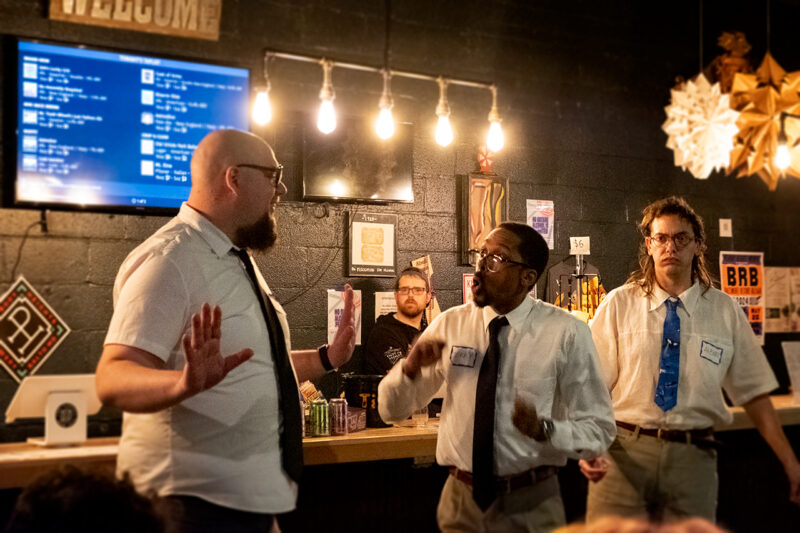Everyman Theatre’s Marathon Set Mashup Places Theatrical Transformation in the Spotlight
By Cara Ober
I can’t stand to watch the Olympics. Especially with gymnastics and figure skating, I’m constantly anticipating a fall or mistake. It’s so stressful that I can’t pay attention, with my eyes covered more than they’re open. Sometimes watching live theater is like this. Witnessing a performance where ambition exceeds ability is painful.
Thankfully, this is not the case at Baltimore’s Everyman Theatre, where acrobatic physical feats of transformation are a daily part of their current performance routine.
After twenty-five years, Everyman has reached an unprecedented level of success. Its cast of resident actors has matured into solid, fluid performers. Its directors choose increasingly ambitious scripts, resulting in challenging and even sublime performances. Their still-new and much larger playhouse in the Bromo Arts District, along with larger budgets than ever before, has given Everyman the ability, even the right, to coast along professionally. It’s worth noting that they’ve chosen a ridiculously daunting challenge for their current run: an epic marathon of not one, but two, American iconic works of theater performed interchangeably.
This month, Everyman offers rotating performances of Arthur Miller’s Death of a Salesman and Tennessee Williams’ A Streetcar Named Desire. Using the same cast of actors, the theater offers the experience of two vastly different plays in one day, with a schedule that reverses each night. Not only does this double performance pose a great challenge to the actors’ ability to transform and engage the audience, it created an unprecedented challenge for Everyman’s set, costume, and lighting designers.
Not only must the mise en scene transform to accentuate each play effectively and in vastly different ways, its designers were given an even more ambitious challenge: to consider the role of theatrical transformation, and to create sets, costumes, and lights that completely change in less than an hour’s time.
This is the first time Everyman has produced rotating performances, and, as far as we know, the first time any theater has staged concurrent performances of Streetcar and Salesman.
Why would they want to tackle such an ambitious project? For the same reason Olympic athletes skate and swim and bike — to see if they can do it, to see how far they can rise. Although a gamble, the dramatic changeover has attracted the attention of the audience in its own right; you can reserve free tickets to observe the transformation on weekend afternoons.
Nick Horan, Media Relations Manager at Everyman, explains. “What is revolutionary about this particular event is the technical wizardry that went into the design of the set… The set was built like a giant interlocking jigsaw puzzle using techniques that wouldn’t have existed 5-10 years ago. The entire concept was designed using 3D imaging software. It was an absolute first for a production of this size in Baltimore.” Horan sees the technical problem solving at Everyman in relation to the growth of maker spaces across the city, and is interested in the ways technology is redefining the limits of theater.
For set designer Daniel Ettinger, the project has been creatively unrivaled in his career. “Vinny [Director Vincent Lancisi] came to me early in the season planning last year, asking whether it was physically possible to even fit these two shows together,” he said. “Just the idea of getting to do this was incredibly exciting to me. Working within the history of iconic scenic design–the idea of being able to work through that lens, yet finding a new way in for our company and our time, was what took away the fear of working on this.”
The resulting skeletal two-story set designed by Ettinger uses 6,560 feet of steel tube, weighs over three tons, and breaks into eleven rolling platforms, which can be locked into place. In addition to a set design that enhances and emphasizes the strengths of the play and actors, Ettinger had to design a set that can be transformed from one play to the other in less than 40 minutes.
 Ettinger, Burdick, and Burgess
Ettinger, Burdick, and Burgess
“Ever since I was a little kid I’ve been fascinated by geometry, how everything fits together,” Ettinger explained. “This was perfect; in considering how different these two worlds are–between Willy’s [Salesman] world, kind of barren and sparse, and also presenting scenes from his mind and memory, and then Streetcar’s world, which is a lush but degraded environment, with a lot of beauty and complexity. In addition to that, I had to think about how to take one apart and put one together, to consider what scenery fits behind another piece, what fits through the door. I love getting to play with those building blocks.”
According to Ettinger, this visual transformation was a team effort between himself, costume designer David Burdick, and lighting designer Harold Burgess. In an interview and backstage tour at the theater, all three designers concurred that working together was the most significant and essential part of the process.
“One of the things we wanted to do is make sure each of these plays is a different experience,” said Burdick, who sews and designs most of the costumes himself. “Some people will come and see them on weekends, both the same day. Both plays were written about same time, in the late 40s, so silhouette-wise, they’re very similar. So, we wanted to visually separate them.”
Since the plays are written in such different styles, Burdick explained how this formed a conceptual contrast between minimal/maximal and warm/cool in their designs. “Salesman is much more abstract because you’re going in and out of Willy’s mind, so we needed to establish a different palette to differentiate reality from fantasy. In Salesman, the world they’re living in is cold and dismal and harsh, so our set is lacking in color, very gray and cool. When you flip that first time into his mind, the world becomes colorized with brighter sharper colors.”
Burdick continued, “In contrast, Streetcar is almost an opera. We wanted to give that lushness and operatic sense, to express that through the clothes. The color palette is a lot warmer and there’s a lot more color in it. It’s a big ambitious play, so there’s a lot of clothes. People think of Stanley is in a tank top and jeans but every time he comes into a scene he changes clothes. Derek Goldman [the director] and I agreed that Stanley is a peacock. His clothes are flashier. These plays are very different experiences; Salesman is very spare and cold while Streetcar is a warm and lush.”
 Costumes and makeup backstage at Everyman
Costumes and makeup backstage at Everyman
Although lighting designer Harold Burgess admits that his work tends to be ephemeral and “harder to wrap your mind around,” he knows he has done his job well when it goes unnoticed by critics. Burgess admitted that designing two sets of lighting with two separate moods was a significant challenge for him as well. Compared to other Everyman shows, there are 50% more lights hanging above the audience. Burgess had to create adjustable lighting plots that must be refocused with each changeover from one play to the other.
“I can trust that much of what will look beautiful rests in what the eye can see and what the eye can’t see,” said Ettinger. “That’s where someone of Harold’s talent becomes so important.”
“I’m not sure how many shows we’ve all worked together now, but working with David and Dan, it really is about trust,” said Burgess. “In the beginning, Dan had a couple different iterations of the set, changing them around. But by the 2nd and 3rd meeting, he had everything mocked up, and I understood where he was going with his own ideas for the environment. The same is true for David. We seldomly discuss color, but I look at his research and it influences what I do – marry to set and color – with his beautiful costumes. The palette is amazing, in terms of costume and light and set. They’ve all come together without any real problems and this is a great thing.”
“Vinny said early on in our design process was what he was looking for was a level of transformation in the characters, showing the audience that level, and showing that visually on stage as well, so there is nothing shared between the two shows,” said Ettinger.
Although the usual wear and tear on the visual elements of the play have been amplified by this athletic feat (Streetcar actors have so far smashed three front doors that have needed rebuilding), the cast and crew have met no major stumbles, and instead have received accolades for their smooth and moving double feat. Watching the plays individually is a rewarding experience, but experiencing their success together, all at once, achieves a dramatic height only accentuated by its visual seamlessness and contrast.
“To create these two separate worlds, side by side, where the palette of the two is so different but still a simultaneous conversation, has been an amazing experience,” said Ettinger. This physical, visual feat at Everyman is unprecedented in the contemporary theater world, but it’s been so successful it’s likely that others will copy it in the future.

Author Cara Ober is Founding Editor at BmoreArt.
For those who want to witness the changeover, it begins at approximately 4:45PM on Saturdays and Sundays and is FREE to attend, although tickets to the changeover must be reserved in advance. For information about Everyman Theatre, visit www.everymantheatre.org.





